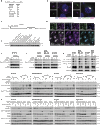Mammalian EAK-7 activates alternative mTOR signaling to regulate cell proliferation and migration
- PMID: 29750193
- PMCID: PMC5942914
- DOI: 10.1126/sciadv.aao5838
Mammalian EAK-7 activates alternative mTOR signaling to regulate cell proliferation and migration
Abstract
Nematode EAK-7 (enhancer-of-akt-1-7) regulates dauer formation and controls life span; however, the function of the human ortholog mammalian EAK-7 (mEAK-7) is unknown. We report that mEAK-7 activates an alternative mechanistic/mammalian target of rapamycin (mTOR) signaling pathway in human cells, in which mEAK-7 interacts with mTOR at the lysosome to facilitate S6K2 activation and 4E-BP1 repression. Despite interacting with mTOR and mammalian lethal with SEC13 protein 8 (mLST8), mEAK-7 does not interact with other mTOR complex 1 (mTORC1) or mTOR complex 2 (mTORC2) components; however, it is essential for mTOR signaling at the lysosome. This phenomenon is distinguished by S6 and 4E-BP1 activity in response to nutrient stimulation. Conventional S6K1 phosphorylation is uncoupled from S6 phosphorylation in response to mEAK-7 knockdown. mEAK-7 recruits mTOR to the lysosome, a crucial compartment for mTOR activation. Loss of mEAK-7 results in a marked decrease in lysosomal localization of mTOR, whereas overexpression of mEAK-7 results in enhanced lysosomal localization of mTOR. Deletion of the carboxyl terminus of mEAK-7 significantly decreases mTOR interaction. mEAK-7 knockdown decreases cell proliferation and migration, whereas overexpression of mEAK-7 enhances these cellular effects. Constitutively activated S6K rescues mTOR signaling in mEAK-7-knocked down cells. Thus, mEAK-7 activates an alternative mTOR signaling pathway through S6K2 and 4E-BP1 to regulate cell proliferation and migration.
Figures






References
-
- Shimobayashi M., Hall M. N., Making new contacts: The mTOR network in metabolism and signalling crosstalk. Nat. Rev. Mol. Cell Biol. 15, 155–162 (2014). - PubMed
-
- Chung J., Kuo C. J., Crabtree G. R., Blenis J., Rapamycin-FKBP specifically blocks growth-dependent activation of and signaling by the 70 kd S6 protein kinases. Cell 69, 1227–1236 (1992). - PubMed
-
- Heitman J., Movva N. R., Hall M. N., Targets for cell cycle arrest by the immunosuppressant rapamycin in yeast. Science 253, 905–909 (1991). - PubMed
Publication types
MeSH terms
Substances
Grants and funding
LinkOut - more resources
Full Text Sources
Other Literature Sources
Molecular Biology Databases
Research Materials
Miscellaneous

